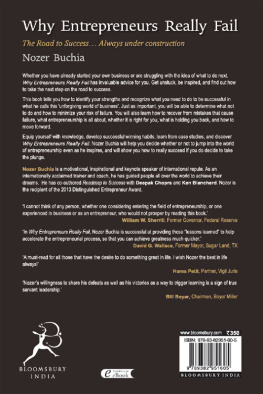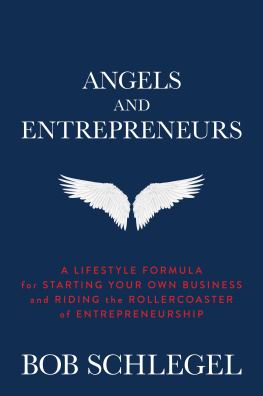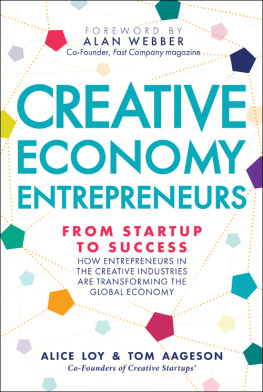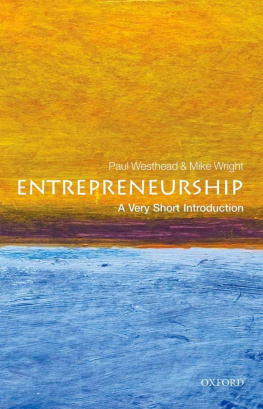Paul Westhead and Mike Wright
ENTREPRENEURSHIP
A Very Short Introduction


Great Clarendon Street, Oxford, ox2 6DP,
United Kingdom
Oxford University Press is a department of the University of Oxford. It furthers the Universitys objective of excellence in research, scholarship, and education by publishing worldwide. Oxford is a registered trade mark of Oxford University Press in the UK and in certain other countries
Paul Westhead and Mike Wright 2013
The moral rights of the authors have been asserted
First Edition published in 2013
Impression: 1
All rights reserved. No part of this publication may be reproduced, stored in a retrieval system, or transmitted, in any form or by any means, without the prior permission in writing of Oxford University Press, or as expressly permitted by law, by licence or under terms agreed with the appropriate reprographics rights organization. Enquiries concerning reproduction outside the scope of the above should be sent to the Rights Department, Oxford University Press, at the address above
You must not circulate this work in any other form and you must impose this same condition on any acquirer
Published in the United States of America by Oxford University Press
198 Madison Avenue, New York, NY 10016, United States of America
British Library Cataloguing in Publication Data
Data available
Library of Congress Control Number: 2013942448
ISBN 978-0-19-967054-3
Printed in Great Britain by
Ashford Colour Press Ltd, Gosport, Hampshire
Contents
Thanks to Stephanie Wright, the anonymous reviewers, and the editors for their comments on an earlier draft.
For Benjamin, Julien, and Stephanie
Entrepreneurship: A Very Short Introduction
Themes explored in entrepreneurship studies
Renovo share price
Inputprocessoutput model of strategic entrepreneurship
From Hitt M. A., et al, Strategic Entrepreneurship: Creating Value for Individuals, Organization, and Society. Academy of Management Perspectives (2011)
Resource orchestration
Overall entrepreneurship rates between countries 2011
From Kelley D., Singer S., and Herrington M. (2012). 2011 Global Entrepreneurship Monitor Executive Report. London: Global Entrepreneurship Research Association (GERA)
Conceptualized types of family firm
The publisher and authors apologize for any errors or omissions in the above list. If contacted they will be happy to rectify these at the earliest opportunity.
Summary of approaches for describing the entrepreneur as an individual
Adapted from Cunningham, J. B. and Lischeron, J. (1991). Defining Entrepreneurship. Journal of Small Business Management, 29(1): 4561
Entrepreneurial rms: positive economic and non-economic contributions and barriers to enterprise
Types of government support for new firm formation and development
Adapted from Storey, D. J. (1994). Understanding the Small Business Sector. London, Thomson Learning
Opportunity discovery versus opportunity creation
2007. Strategic Management Society. Published by John Wiley & Sons, Ltd
Causation and effectuation views on the source of opportunity
Adapted from Read, S., Sarasvathy, S., Dew, N., Wiltbank, R., and Ohlsson, A. (2011) Effectual Entrepreneurship. New York: Routledge
Links between effectuation process steps and bricolage actions
Elements of a business plan
Views on new small business development and the individual
Adapted from Gibb, A. and Ritchie, J. (1982). Understanding the Process of Starting Small Businesses. European Small Business Journal, 1(1): 2645
Influences on the development of entrepreneurial ideas and ambitions at different stages of life
Adapted from Gibb A., Enterprise Culture ID Meaning and Implications for Education and Training (1987). Journal of European Industrial Training
Regional variations in new firm formation rates across seven European Community countries
Adapted from Reynolds, P., Storey, D. J., and Westhead, P. (1994). Cross-National Comparisons of the Variation in New Firm Formation Rates. Regional Studies, 28(4): 443456
Smiths profiles of craftsman and opportunist entrepreneurs
Categorization of habitual entrepreneurship
Main hurdles reported at work by women
From Kariv, D. (2013). Female Entrepreneurship and the New Venture Creation: An International Perspective. London: Routledge
Micro and macro perspectives and female entrepreneurship
From Kariv, D. (2013). Female Entrepreneurship and the New Venture Creation: An International Perspective. London: Routledge
Personality trait dimensions in entrepreneurship studies
Cognitive heuristics and biases in entrepreneurship
Advantages and disadvantages of family firms
Barriers to succession planning in family firms
Adapted from Kets de Vries. (1993). The dynamics of family controlled firms: The good and the bad news. Organizational Dynamics, 21(2): 13
Corporate entrepreneurship terminology
Adapted from Sharma P. and Chrisman J. J. (1999). Toward a Reconciliation of the Definitional Issues in the Field of Corporate Entrepreneurship. Entrepreneurship Theory and Practice, 23(3): 1127
Corporate entrepreneurship (CE) attributes
Adapted from Covin J. and Miles M. (1999). Corporate Entrepreneurship and the Pursuit of Competitive Advantage. Entrepreneurship Theory and Practice, 23(3): 4763
Typology of buyouts
Types of academic spin-off firm
The publisher and authors apologize for any errors or omissions in the above list. If contacted they will be happy to rectify these at the earliest opportunity.
We appear to be living in a golden age for entrepreneurship. In 2011, a Global Entrepreneurship Monitor (GEM) survey of more than 140,000 adults (1864 years of age) in fifty-four economies estimated that 388 million entrepreneurs were actively engaged in starting and running new businesses. Entrepreneurs can be vital agents of innovative change whose actions lead to the creation of new firms. They can also transform existing firms to exploit economic and socially beneficial opportunities. In the popular media, entrepreneurs are often presented playing a key role in promoting economic development. Indeed, GEM studies have discovered a significant link between the rate of entrepreneurial activity in a country and growth in that countrys gross domestic product (GDP), although the link is not consistent across all countries. Entrepreneurs and their businesses can generate wealth and jobs, which can enable social and regional inequality to be reduced. Entrepreneurs can be pulled into entrepreneurship because they want to exploit a perceived business opportunity, or pushed into it of necessity because they have no other options for work. Either way, they are increasingly seen as the panacea to solve national and local development issues.
The expectation that entrepreneurs can provide the panacea to economic ills may be an unrealistic one. Joseph Schumpeter warned that while entrepreneurial acts create new sources of competitive advantage, products and services, firms, industries, jobs, and wealth, at the same time they also destroy firms and jobs in now out-of-date activities. In the popular mindset entrepreneurs are often portrayed as heroic yet maverick individuals, single-handedly and relentlessly pursuing opportunity and enjoying exotic lifestyles as a result. The dominant popular entrepreneur image relates to a Western heroic white male figure exhibiting aggression and assertiveness to create or discover business opportunities. But, when businesses close, with people losing their jobs and nefarious activities being revealed, some of the same entrepreneurs are then castigated as villains (e.g. Conrad Black, Robert Maxwell, Asil Nadir). So entrepreneurs can be heroes and villains, sometimes both at the same time depending on your point of view. Books about Richard Branson, for example, have presented conflicting portraits ranging from adventurous global entrepreneur to cunning and ruthless operator with a knack for undermining his rivals.
Next page











